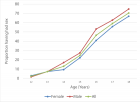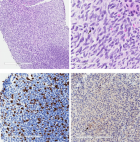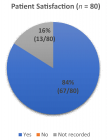Abstract
Research Article
Quantifying Levels of Selected Metals in Different Rice Brands
Jamila M Machano, Abdul AJ Mohamed* and Said S Bakar
Published: 29 August, 2024 | Volume 8 - Issue 1 | Pages: 072-075
This research focused on assessing the levels of selected metal contamination in seven different rice brands (Jasmine, Basmati, Mapembe, Morogoro, Shinyanga, Mbeya, and Cheju). Cheju rice was obtained from local producers from the Cheju area in Zanzibar, while the remaining rice brands namely, Jasmine, Basmati, Mapembe, Morogoro, Shinyanga, and Mbeya were randomly taken from local markets at Darajani and Mwanakwerekwe in Zanzibar. Samples were prepared in accordance with applicable Safe Operating Procedures (SOPs) and laboratory SOPs using information provided by field sample preparation. The samples were ground to fineness and an aliquot of about 10.0 g was measured on the beam balance and mounted on the sample holders for laboratory analysis. An Energy Dispersive X-Ray Fluorescence (EDXRF) technique with a Rigaku NEX CG EDXRF model spectrometer was used for metal analysis. The study revealed that the percentage of metal contamination varied considerably from one rice brand to another, with Basmati and Jasmine rice each exhibiting a contamination level of 50%, while Shinyanga, Mbeya, Mapembe, and Cheju rice showed a level of 25% each. Notably, Morogoro rice had no observable heavy metal contamination. Additionally, a significant positive correlation was observed between several metal pairs: Au and Cr (r² = 1.00), Au and Ti (r² = 0.613), Cr and Ti (r² = 0.613), Ni and Pb (r² = 0.748), Ni and Hf (r² = 0.660), Pb and Hf (r² = 0.656), and Ti and Sn (r² = 0.671). The individual occurrence (percentage) for metals across all rice brands were as follows: 71.42% for Sn, and 28.57% for Hf, Ni, Pb, and Ti, while traces of Au, Cr, and Y each had an occurrence level of 14.28%. While Morogoro rice showed no metal discernible analyzed heavy metal contamination, the other rice brands were observed to have a considerable heavy metal contamination trend. The patterns of metal occurrence in each rice brand were observed as follows: Basmati: Sn > Ti > Au > Cr; Jasmine: Sn > Hf > Ni > Pb; Shinyanga: Sn > Pb; Mbeya: Sn > Hf; Mapembe: Sn > Ti; Cheju: Ni > Y. The patterns, then yield the ranking of metal contamination across all seven rice brands from lowest to highest is as follows: Morogoro < (Mapembe, Cheju, Mbeya, Shinyanga) < (Jasmine, Basmati). Furthermore, the data analysis indicated that the concentrations of Cr (1.08 mg/Kg), Ni (4.65 mg/Kg), and Pb (3.05 mg/Kg) detected in the samples surpassed the maximum permissible limits established by WHO/FAO which were 1.0 mg/Kg, 0.10 mg/Kg and 0.20 mg/Kg respectively. Consequently, the study concludes that Morogoro rice is the most superior and considered the safest choice for consumption, while Jasmine and Basmati rice are associated with higher levels of metal contamination. Thus, it is highly recommended that Tanzania intensify its rice cultivation efforts to reduce reliance on rice imports from other nations.
Read Full Article HTML DOI: 10.29328/journal.acee.1001070 Cite this Article Read Full Article PDF
Keywords:
Hafnium; Lead; Titanium; Mapembe; Basmati; Cheju
References
- Chan M. Food safety must accompany food and nutrition security. Lancet. 2014 Nov 29;384(9958):1910-1. Available from:https://doi.org/10.1016/s0140-6736(14)62037-7
- Fukagawa NK, Ziska LH. Rice: Importance for Global Nutrition. J Nutr Sci Vitaminol (Tokyo). 2019;65(Supplement):S2-S3. doi: 10.3177/jnsv.65.S2. PMID: 31619630. Available from: https://doi.org/10.3177/jnsv.65.s2
- Mosleh MK, Hassan QK, Chowdhury EH. Application of remote sensors in mapping rice area and forecasting its production: a review. Sensors (Basel). 2015 Jan 5;15(1):769-91. Available from: https://doi.org/10.3390/s150100769
- Saleem MH, Ali S, Seleiman MF, Rizwan M, Rehman M, Akram NA, et al. Assessing the Correlations between Different Traits in Copper-Sensitive and Copper-Resistant Varieties of Jute (Corchorus capsularis). Plants (Basel). 2019 Nov 26;8(12):545. Available from: https://doi.org/10.3390/plants8120545
- Saleem MH, Fahad S, Rehman M, Saud S, Jamal Y, Khan S, et al. Morpho-physiological traits, biochemical response and phytoextraction potential of short-term copper stress on kenaf (Hibiscus cannabinus) seedlings. PeerJ. 2020 Jan 30;8:e8321. Available from: https://doi.org/10.7717/peerj.8321
- Cong W, Miao Y, Xu L, Zhang Y, Yuan C, Wang J, et al. Transgenerational memory of gene expression changes induced by heavy metal stress in rice (Oryza sativa L.). BMC Plant Biol. 2019 Jun 27;19(1):282. Available from: https://doi.org/10.1186/s12870-019-1887-7
- Wei R, Chen C, Kou M, Liu Z, Wang Z, Cai J, et al. Heavy metal concentrations in ricethat meet safety standards can still pose a risk to human health. Communications earth & environment. 2023: 4(84), 723-727.
- Fuller R, Landrigan PJ, Balakrishnan K, Bathan G, Bose-O'Reilly S, Brauer M, et al. Pollution and health: a progress update. Lancet Planet Health. 2022 Jun;6(6):e535-e547. doi: 10.1016/S2542-5196(22)00090-0. Epub 2022 May 18. Erratum in: Lancet Planet Health. 2022 Jul;6(7):e553. Available from: https://doi.org/10.1016/s2542-5196(22)00090-0
- Garbinski LD, Rosen BP, Chen J. Pathways of arsenic uptake and efflux. Environ Int. 2019 May;126:585-597. doi: 10.1016/j.envint.2019.02.058. Epub 2019 Mar 8. PMID: 30852446; PMCID: PMC6472914. Available from: https://doi.org/10.1016/j.envint.2019.02.058
- Zhao K, Fu W, Ye Z, Zhang C. Contamination and spatial variation of heavy metals in the soil-rice system in Nanxun County, Southeastern China. Int J Environ Res Public Health. 2015 Jan 28;12(2):1577-94. Available from: https://doi.org/10.3390/ijerph120201577
- Chamannejadian A, Sayyad G, Moezzi A, Jahangiri A. Evaluation of estimated daily intake (EDI) of cadmium and lead for rice (Oryza sativa L.) in calcareous soils. Iranian J Environ Health Sci Eng. 2013 Apr 8;10(1):28. Available from: https://doi.org/10.1186/1735-2746-10-28
- Tchounwou PB, Yedjou CG, Patlolla AK, Sutton DJ.Heavy Metals Toxicity and the Environment. EXS, 2012:101, 133–164.
- Tumolo M, Ancona V, De Paola D, Losacco D, Campanale C, Massarelli C, et al. Chromium Pollution in European Water, Sources, Health Risk, and Remediation Strategies: An Overview. Int J Environ Res Public Health. 2020 Jul 28;17(15):5438. Available from: https://doi.org/10.3390/ijerph17155438
- Kumar A, Kumar A, M M S CP, Chaturvedi AK, Shabnam AA, et al. Lead Toxicity: Health Hazards, Influence on Food Chain, and Sustainable Remediation Approaches. Int J Environ Res Public Health. 2020 Mar 25;17(7):2179. Available from: https://doi.org/10.3390/ijerph17072179
- Mason LH, Harp JP, Han DY. Pb neurotoxicity: neuropsychological effects of lead toxicity. Biomed Res Int. 2014;2014:840547. Available from: https://doi.org/10.1155/2014/840547
- Poonkothai M, Vijayavathi S. Nickel as an essential element and a toxicant, International Journal of Engineering, Science and Technology. 2012: 1(4), 285-288.
- Falah SA, Saja NM. Essential Trace Elements and Their Vital Roles in Human Body. Indian Journal of Advances in Chemical Science. 2017: 5(3), 127-136. Available online at ijacskros.com. (in table)
- Widowati S. Karakteristik Beras Instan Fungsional dan Peranannya dalam Menghambat Kerusakan Pankreas. Jurnal Pangan Edisi No. 52/XVII/Oktober-Desember/2008.
- Ok YS, Usman AR, Lee SS, Abd El-Azeem SA, Choi B, Hashimoto Y, Yang JE. Effects of rapeseed residue on lead and cadmium availability and uptake by rice plants in heavy metal contaminated paddy soil. Chemosphere. 2011 Oct;85(4):677-82. Available from: https://doi.org/10.1016/j.chemosphere.2011.06.073
- Ashraf U, Hussain S, Anjum SA, Abbas F, Tanveer M, Noor MA, et al. Alterations in growth, oxidative damage, and metal uptake of five aromatic rice cultivars under lead toxicity. Plant Physiol Biochem. 2017 Jun;115:461-471. Available from: https://doi.org/10.1016/j.plaphy.2017.04.019
- Zulkafflee NS, Mohd Redzuan NA, Hanafi Z, Selamat J, Ismail MR, Praveena SM, et al. Heavy Metal in Paddy Soil and its Bioavailability in Rice Using In Vitro Digestion Model for Health Risk Assessment. Int J Environ Res Public Health. 2019 Nov 28;16(23):4769. Available from: https://doi.org/10.3390/ijerph16234769
- Szkup-Jabłońska M, Karakiewicz B, Grochans E, Jurczak A, Nowak-Starz G, et al. Effects of blood lead and cadmium levels on the functioning of children with behaviour disorders in the family environment. Ann Agric Environ Med. 2012;19(2):241-6. Available from: https://pubmed.ncbi.nlm.nih.gov/22742795/
- Norton GJ, Williams PN, Adomako EE, Price AH, Zhu Y, Zhao FJ, et al. Lead in rice: analysis of baseline lead levels in market and field collected rice grains. Sci Total Environ. 2014 Jul 1;485-486:428-434. Available from: https://doi.org/10.1016/j.scitotenv.2014.03.090
- Goyer R. Issue Paper on the Human Health Effects of Metals. U.S. Environmental Protection Agency. Risk Assessment Forum. Washington, DC. 2004.
- Halder D, Saha JK, Biswas A. Accumulation of essential and non-essential trace elements in rice grain: Possible health impacts on rice consumers in West Bengal, India. Sci Total Environ. 2020 Mar 1;706:135944. Available from: https://doi.org/10.1016/j.scitotenv.2019.135944
- Report of the 29th session of the codex Alimentarius commission. 2006: Rome; Report No.: ALINORM 06/29/41. http://www.fao.org/tempref/codex/Reports/Alinorm06/al29_03e.pdf
- Hasan GMMA, Das AK, Satter MA. Accumulation of Heavy Metals in Rice (Oryza sativa. L) Grains Cultivated in Three Major Industrial Areas of Bangladesh. J Environ Public Health. 2022 Mar 8;2022:1836597. Available from: https://doi.org/10.1155/2022/1836597
- WHO/FAO. codex alimentarius commission committee on standard programme for contaminants in foods. Fifth session, document CX/CF 07/1/6, 21-25 march, 2011. Available online: http://www.fao.org/tempref/codex/Meetings/CCCF/CCCF5/cf0 5_INF.pdf
- Menghua X, Yuanyuan L. Distribution Characteristics and Ecological Risk Assessment of Heavy Metals under Reclaimed Water Irrigation and Water Level Regulations in Paddy Field. Pol. J. Environ. Stud., 2022: 31(3), 2355-2365.
- Tegegne B, Chandravanshi BS, Zewge F. Levels of selected metals in commercially available rice in Ethiopia. International Food Research Journal. 2017: 24(2), 711-719.
- Tatah Mentan M, Nyachoti S, Scott L, Phan N, Okwori FO, et al. Toxic and Essential Elements in Rice and Other Grains from the United States and Other Countries. Int J Environ Res Public Health. 2020 Nov 3;17(21):8128. Available from: https://doi.org/10.3390/ijerph17218128
- Mohammed NK.Nuclear Techniques Applied to Biological Samples from Tanzania to Monitor the Nutritional Status of Children. Faculty of Engineering and Physical Sciences. University of Surrey. 2008.
Figures:
Similar Articles
-
Use of Geosynthetic materials in solid waste landfill design: A review of geosynthetic related stability issuesMA Karim*,Lin Zhao. Use of Geosynthetic materials in solid waste landfill design: A review of geosynthetic related stability issues. . 2018 doi: 10.29328/journal.acee.1001010; 2: 006-015
-
Effect of cement solidification on strength and leaching properties of Heavy Metals Contaminated SoilSyed Taseer Abbas Jaffar*,Sajjad Yousefi Oderji,Si-an Zhang,Long-zhu Chen. Effect of cement solidification on strength and leaching properties of Heavy Metals Contaminated Soil. . 2018 doi: 10.29328/journal.acee.1001011; 2: 016-027
-
Industrial control systems: The biggest cyber threatChristos P Beretas*. Industrial control systems: The biggest cyber threat. . 2020 doi: 10.29328/journal.acee.1001026; 4: 044-046
-
Behavior evaluation of freundlich and langmuir isotherms in cadmium preconcentration using solid phase extraction method for linear and nonlinear numerical computational patternsBenyamin Chahkandi,Mohammad Gheibi*,Amir Takhtravan. Behavior evaluation of freundlich and langmuir isotherms in cadmium preconcentration using solid phase extraction method for linear and nonlinear numerical computational patterns. . 2021 doi: 10.29328/journal.acee.1001029; 5: 007-010
-
Nano-silica from kaolinitic clay used as adsorbent for anionic and cationic dyes removal: linear and non-linear regression isotherms and kinetics studiesGustave Tchanang,Chantale Njiomou Djangang*,Charles Fon Abi,Danie Laure Mbella Moukouri,Guillonnel Trésor Nyadjou Djabo,Jean Marie Kepdieu,Philippe Blanchart. Nano-silica from kaolinitic clay used as adsorbent for anionic and cationic dyes removal: linear and non-linear regression isotherms and kinetics studies. . 2022 doi: 10.29328/journal.acee.1001034; 6: 008-018
-
Bioaccumulation of As, Cd, Cr, Cu, Pb, Zn in Ambrosia artemisiifolia L. in the polluted area by enterprise for the production and processing of batteriesRyzhenko Nataliia*,El Amrani Abdelhak,Giltrap Michelle,Furong Tian,Volodymyr Laptev. Bioaccumulation of As, Cd, Cr, Cu, Pb, Zn in Ambrosia artemisiifolia L. in the polluted area by enterprise for the production and processing of batteries. . 2022 doi: 10.29328/journal.acee.1001036; 6: 026-030
-
Evaluation of factors affecting the quality of luxury residential buildings using the fuzzy BWM methodMarziyeh Sadat Moayeri, Seyed Azim Hosseini*, Mehdi Nani, Hamidreza Rabieifar, Jafar Asadpour. Evaluation of factors affecting the quality of luxury residential buildings using the fuzzy BWM method. . 2023 doi: 10.29328/journal.acee.1001049; 7: 007-013
-
Understanding RNG Gas Quality through Execution at Newtown Creek WRRF RNGPradheep Kileti*, Brian Barkwill, Devinder Mahajan. Understanding RNG Gas Quality through Execution at Newtown Creek WRRF RNG. . 2023 doi: 10.29328/journal.acee.1001051; 7: 017-023
-
Sea Level Rise Impacts in Coastal Areas and Possible Mitigation Engineering ApproachesSilvano Focardi, Milva Pepi*. Sea Level Rise Impacts in Coastal Areas and Possible Mitigation Engineering Approaches. . 2023 doi: 10.29328/journal.acee.1001053; 7: 030-036
-
Isolation and Influence of Carbon Source on the Production of Extracellular Polymeric Substance by Bacteria for the Bioremediation of Heavy Metals in Santo Amaro CityLeila Thaise Santana de Oliveira Santos*, Kayque Frota Sampaio, Elisa Esposito, Elinalva Maciel Paulo, Aristóteles Góes-Neto, Amanda da Silva Souza, Taise Bomfim de Jesus. Isolation and Influence of Carbon Source on the Production of Extracellular Polymeric Substance by Bacteria for the Bioremediation of Heavy Metals in Santo Amaro City. . 2024 doi: 10.29328/journal.acee.1001060; 8: 012-017
Recently Viewed
-
Comparative Analysis of Demographic and Clinical Profiles of Conventional Retinopathy of Prematurity with Aggressive Posterior Retinopathy of PrematuritySakshi Lochab*, Manisha Mada, Ritesh Verma, Jitender Phogat. Comparative Analysis of Demographic and Clinical Profiles of Conventional Retinopathy of Prematurity with Aggressive Posterior Retinopathy of Prematurity. Int J Clin Exp Ophthalmol. 2024: doi: 10.29328/journal.ijceo.1001057; 8: 016-020
-
The Synergistic Effect of Combined Linagliptin and Metformin Improves Hepatic Function in High-fat Diet/Streptozotocin-induced Diabetic RatsFolasade Omobolanle Ajao*,Ifedolapo Opeyemi Adeyeye,Noheem Olaoluwa Kalejaiye,Sodik Olasunkami Mukaila,Olalekan Samson Agboola,Marcus Olaoye Iyedupe. The Synergistic Effect of Combined Linagliptin and Metformin Improves Hepatic Function in High-fat Diet/Streptozotocin-induced Diabetic Rats. Ann Clin Gastroenterol Hepatol. 2025: doi: 10.29328/journal.acgh.1001050; 9: 004-012
-
The Accuracy of pHH3 in Meningioma Grading: A Single Institution StudyMansouri Nada1, Yaiche Rahma*, Takout Khouloud, Gargouri Faten, Tlili Karima, Rachdi Mohamed Amine, Ammar Hichem, Yedeas Dahmani, Radhouane Khaled, Chkili Ridha, Msakni Issam, Laabidi Besma. The Accuracy of pHH3 in Meningioma Grading: A Single Institution Study. Arch Pathol Clin Res. 2024: doi: 10.29328/journal.apcr.1001041; 8: 006-011
-
Assessment of Perceptions of Nursing Undergraduates towards Mental Health PracticesAlya Algamdii*. Assessment of Perceptions of Nursing Undergraduates towards Mental Health Practices. Clin J Nurs Care Pract. 2025: doi: 10.29328/journal.cjncp.1001059; 9: 007-011
-
Multipurpose Antioxidants based on Food Industry Waste: Production and Properties EvaluationToshkhodjaev*. Multipurpose Antioxidants based on Food Industry Waste: Production and Properties Evaluation. Arch Food Nutr Sci. 2025: doi: 10.29328/journal.afns.1001062; 9: 001-003
Most Viewed
-
Feasibility study of magnetic sensing for detecting single-neuron action potentialsDenis Tonini,Kai Wu,Renata Saha,Jian-Ping Wang*. Feasibility study of magnetic sensing for detecting single-neuron action potentials. Ann Biomed Sci Eng. 2022 doi: 10.29328/journal.abse.1001018; 6: 019-029
-
Evaluation of In vitro and Ex vivo Models for Studying the Effectiveness of Vaginal Drug Systems in Controlling Microbe Infections: A Systematic ReviewMohammad Hossein Karami*, Majid Abdouss*, Mandana Karami. Evaluation of In vitro and Ex vivo Models for Studying the Effectiveness of Vaginal Drug Systems in Controlling Microbe Infections: A Systematic Review. Clin J Obstet Gynecol. 2023 doi: 10.29328/journal.cjog.1001151; 6: 201-215
-
Prospective Coronavirus Liver Effects: Available KnowledgeAvishek Mandal*. Prospective Coronavirus Liver Effects: Available Knowledge. Ann Clin Gastroenterol Hepatol. 2023 doi: 10.29328/journal.acgh.1001039; 7: 001-010
-
Causal Link between Human Blood Metabolites and Asthma: An Investigation Using Mendelian RandomizationYong-Qing Zhu, Xiao-Yan Meng, Jing-Hua Yang*. Causal Link between Human Blood Metabolites and Asthma: An Investigation Using Mendelian Randomization. Arch Asthma Allergy Immunol. 2023 doi: 10.29328/journal.aaai.1001032; 7: 012-022
-
An algorithm to safely manage oral food challenge in an office-based setting for children with multiple food allergiesNathalie Cottel,Aïcha Dieme,Véronique Orcel,Yannick Chantran,Mélisande Bourgoin-Heck,Jocelyne Just. An algorithm to safely manage oral food challenge in an office-based setting for children with multiple food allergies. Arch Asthma Allergy Immunol. 2021 doi: 10.29328/journal.aaai.1001027; 5: 030-037

HSPI: We're glad you're here. Please click "create a new Query" if you are a new visitor to our website and need further information from us.
If you are already a member of our network and need to keep track of any developments regarding a question you have already submitted, click "take me to my Query."




















































































































































